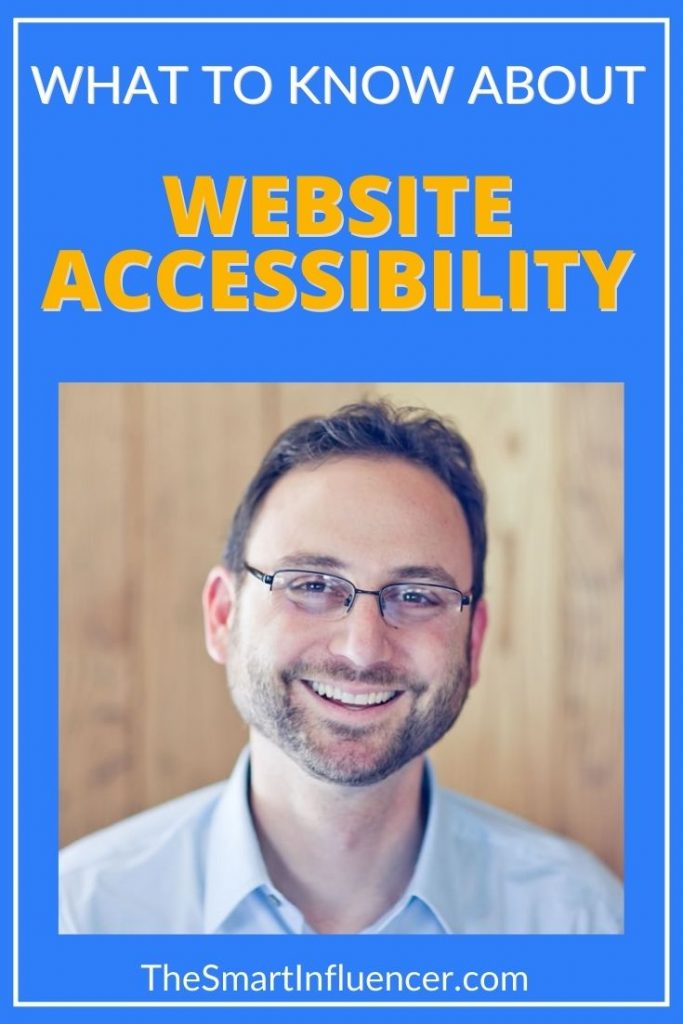What You Need to Know About Website Accessibility
Are you wondering how you can increase your blog’s website accessibility so that all of your users can access your content? In this week’s podcast, guest Andrew Wilder shares how you can make your blog useable for everyone regardless of disability or special need.

The need to include every individual in the happenings of daily life is so important in today’s society. Your blog should be no exception and should seek to anticipate users with disabilities so that they may have a positive web experience.
It may seem like a challenge, however crafting your blog to cater to those with additional needs isn’t difficult to do! As Andrew Wilder explains, increasing your blog’s website accessibility only comes with many benefits such as a boost in SEO! Plus, your blog can see a growth in user activity due to its inclusivity!
EPISODE 021: WHAT YOU NEED TO KNOW ABOUT WEBSITE ACCESSIBILITY
About Andrew Wilder
Andrew Wilder is the founder and CEO of NerdPress, a digital agency that provides WordPress maintenance and support for hundreds of publishers and small businesses, placing an emphasis on site speed, stability, and security. He has been building, breaking, fixing, and maintaining websites since 1998, and has spoken on a wide variety of technical topics (in plain English!) at conferences such as WordCamp LAX, the International Association of Culinary Professionals, Tastemaker, Food & Wine, Techmunch, BlogHer, and Mediavine.
What is Website Accessibility?
As Andrew Wilder explains, website accessibility is making your website or blog accessible for those with disabilities. These disabilities can include ones that are permanent, temporary, invisible, or situational. No matter the disability, its very important for bloggers to make sure their website and its software are accessible for everyone.
A big issue that bloggers should be aware of when it comes to website accessibility is lawsuits. There is an increase of blogs being sued for having faults that are not on par with the needs of the disabled. It is really important to make sure your blog meets basic website requirements so that you don’t end up in this position!
On a better note, having good website accessibility is good for business! The easier you make your website to use the more likely that your users will be attracted to it. Also, you can increase your website’s SEO! The gains alone are worth giving your blog a look over to see if its meeting requirements.
“If your website is accessible…[users] are going to stay on your site.”
Website Accessibility Standards Every Blog Should Follow
The website accessibility standards you as a blogger should follow can be broken down into four categories. The first is that your website content has to be perceivable. For example, if a user of your site is blind, try to offer an option for auditory assistance so that they may understand what a particular part of your website is about. The next is that your website must be operable. Any user must be able to operate your website’s interface without issue.
To continue, your website should be understandable. Any user should be able to know what the site is about and how to easily operate its interface. Lastly, your website should be robust, meaning it should be compatible with any number of assisted technologies and devices.
Following these four steps will ensure that your website meets basic guideline requirements. It is a good idea to double check your site to make sure it meets these standards so that your users can continue to have a positive experience.
How using a Website Accessibility Checker can help your blog
Andrew Wider states that there are six important aspects of your website that can be evaluated with a website accessibility checker to make sure they do not hinder a users experience with your site. They are:
1.) Font size. Use reasonably large fonts for your readers on all parts of your blog.
2.) Zoom. Your page must be able to zoom in by 200%, but make sure that it still looks good when you do!
3.) Contrast. Make sure that any font does not blend into a page’s background and that the background itself isn’t too dark.
4.) Don’t use color as the only means to convey information. Remember, your website needs to be perceivable by all users. This includes those who might be colorblind! Its also important to note that hyperlinks should have some other way of being identifiable (other than being highlighted in blue) so that users can know what they are.
5.) Be intentional with link text. Buttons or icons that state “click here,” or “more” shouldn’t be used due to some users being unable to sense or understand the intention behind it. Also, don’t make URLs visible on a page. Screen readers will read out the whole URL to a user and, well, it’s just annoying and repetitive to hear.
6.) Use headings and subheadings correctly. Doing so helps people with assistance devices progress through a page with ease.
Making sure your website follows these rules can be daunting, but there are many website accessibility checkers out there to help! Google and the platform Wave have fundamentals that are able to access your page and discover if there are any accessibility errors. Also, using an accessibility specialist to check your website can really help pinpoint the places that your website needs to be worked on.
Nerpress, Andrew Wilder’s own website, can also offer assistance in evaluating website accessibility. They offer a wide range of helpful tools and resources to help propel your site forward. Getting your website checked can really help protect your blog and ensure that you consider all of your users needs!
“User experience is key!”
What’s Next
You can connect with Andrew Wilder at [email protected]
Rate, Review, & Subscribe on Apple Podcasts
If you liked this episode, please consider rating and reviewing my show on your favorite podcast app. As always, I’d love to know what you learned in today’s show – send me a DM on Instagram to let me know.

Add A Comment